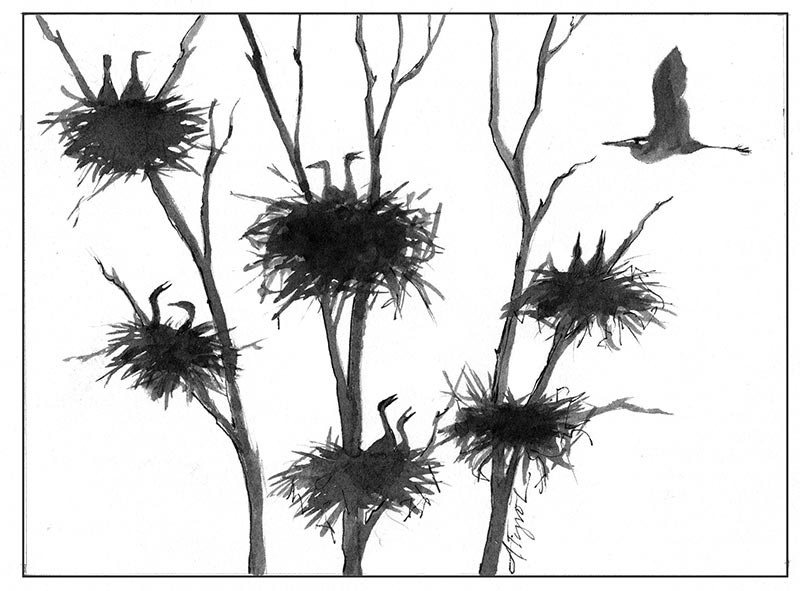
Years ago, friends and I spotted a group of huge nests high in the trees along the edge of a large pond: a great blue heron rookery. From across the water (a respectful distance to avoid disturbing the birds), we observed the goings-on through our binoculars. Adult herons flew in and out of the colony, their long necks and heads folded back onto their shoulders in an S-shape, wings beating slowly, long legs trailing behind. As a parent approached its nest, the young stood up eagerly, jostling each other and clamoring for food. Alighting on the stick platform, the adult quickly inserted its long beak into each nestling’s throat, and with a pumping motion, regurgitated a nutritious soup, which likely included fish, crayfish, or frogs.
Great blue herons are one of the few bird species in the Northeast that nest in inland freshwater colonies (they also nest along saltwater). According to Kent McFarland, a biologist with the Vermont Center for Ecostudies, most heron rookeries in the state are small, with two to three nests, and are located in beaver swamps with big standing dead trees. Many colonies are ephemeral. When the nesting trees fall down or the beavers move on, the herons leave, following the beavers. Vermont’s largest rookery is on an island in the Missisquoi National Wildlife Refuge, a huge riverine wetland complex adjacent to Lake Champlain, and hosts between 250 to 600 nests each year.
Herons usually breed in colonies, explained McFarland, because their preferred nesting habitat tends to be clumped. Good nesting trees with easy access to food are limited, so even at a successful nesting site, herons may have to fly a couple of miles to catch sufficient prey. Another advantage to colony nesting is that there is safety in numbers; there are more eyes to detect predators. The colony may also function as an information center for finding food. One researcher found that herons that followed their neighbors caught more fish than solitary feeders. The rookery also serves as an assembly site for mating. Herons are mostly monogamous during a breeding season, but choose new mates every year.
Male great blues return from southern wintering grounds first, arriving at colonies in mid to late March. They settle on nest sites and court the later-arriving females from there, with elaborate displays performed by both sexes. Herons mainly nest in trees, but will also nest on the ground, on cliffs, in bushes, and on man-made structures such as duck blinds or nest platforms.
The male collects much of the nesting material, gathering sticks and presenting them to the female. She weaves a platform with a nest cup, lining it with pine needles, moss, grass, or leaves. The same nest may be used for several years and grow as large as four feet across and three and a half feet deep. The female lays two to six pale blue eggs, and the parents take turns incubating and turning them with their bills.
Unlike many songbirds and other fast-nesting species, herons invest a significant portion of the spring and summer into one brood of young. Incubation requires approximately 28 days. As the parents exchange nest care duties, they often perform a ritual, erecting their plumes and clicking their bill tips rapidly. The chicks hatch covered with gray down and bluish eyes open; they will stay in the nest for 49 to 81 days, being fed and cared for by their parents. As the baby herons grow larger, the parents will give their chicks their first opportunities to practice picking up prey. They do this by regurgitating small whole fish into the nest. A full two months after hatching, the young attempt their first awkward flights. Fledging also takes time and it’s typical for the young birds to loiter around the nest for a few weeks.
Although great blue herons were hunted heavily for their beautiful plumes (used to adorn women’s hats) in the nineteenth and early twentieth centuries, they are now protected by law, and their populations have rebounded.
Great blue numbers are stable or rising in the Northeast, according to McFarland. The most recent Vermont Breeding Bird Atlas (2010) showed a 28 percent increase in survey blocks occupied by herons since the first atlas in the 1980s. New York’s atlas found a similar 20 percent upswing. However great blues are still considered vulnerable because their nesting colonies are very sensitive to disturbance. One year herons abandoned the large rookery in the Missisquoi Refuge, probably because of high predation rates by raccoons and eagles. Herons can also be disturbed by nearby housing or industrial development, highway construction, and water recreation. It is best to avoid colonies during nesting season, and landowners with breeding herons can help by wrapping sheets of metal around the bases of nesting trees before breeding season to deter predators.
While it’s a rare to have the opportunity to see a rookery, blue herons themselves are relatively easy to find this time of year, as they travel our wetlands and waterways in search of their next prey. They’re exceptionally beautiful birds and it’s fascinating to watch them hunt – standing motionless in the water, looking like a Japanese painting, then spearing a fish and gulping it down. As they take flight, notice in what direction they go; chances are, they’re heading back to a nest to feed their family.


Discussion *